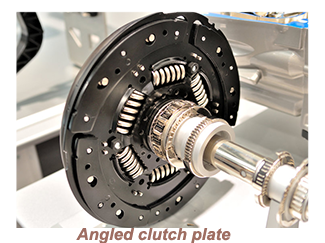
The role of the clutch in a classic car is to connect two or more rotating shafts; one coming from the engine and the other that turns the wheels. The clutch is one of the most important parts of the car’s working system as the engine is creating power all the time.
 To change the speed of the car and stop it completely without turning off the’s engine, the connection between your engine and wheels needs to be interrupted temporarily. There are two major parts of the clutch: the clutch plate and the flywheel. There is a set of springs that pushes the pressure plate against the clutch plate when your foot is not pressing down the clutch pedal.
To change the speed of the car and stop it completely without turning off the’s engine, the connection between your engine and wheels needs to be interrupted temporarily. There are two major parts of the clutch: the clutch plate and the flywheel. There is a set of springs that pushes the pressure plate against the clutch plate when your foot is not pressing down the clutch pedal.
![]()
Clutches are one of the most useful devices in the mechanical systme , as a result of its two rotating shafts. One of them is driven by a pulley or a motor, whereas the other one drives another device. These two shafts are connected by the clutch so that they can spin together when locked or be unlocked and spin at different speeds.  Flywheels and clutch plates.
Flywheels and clutch plates.
A classic car engine is connected to the flywheel whereas the clutch plate is connected to the transmission. As the driver presses down the pedal, the pressure plate is pushed against the clutch disc. This movement works against the flywheel. This mechanism allows the engine to spin at the same speed as earlier.
To ensure that a classic car clutch is functioning correctly, you can perform the following steps:
![]() The first step in determining if the clutch is functioning correctly is to evaluate the pedal feel. The clutch pedal should have a smooth and consistent feel throughout its range of motion.
The first step in determining if the clutch is functioning correctly is to evaluate the pedal feel. The clutch pedal should have a smooth and consistent feel throughout its range of motion.  If the pedal feels spongy or has excessive play, it could indicate a problem with the hydraulic system or worn components.
If the pedal feels spongy or has excessive play, it could indicate a problem with the hydraulic system or worn components.
![]() The clutch should engage smoothly and consistently. The engagement point should be in the same place every time you depress the clutch pedal. If the engagement point is inconsistent or the clutch slips, it could indicate a worn clutch plate or a problem with the hydraulic system.
The clutch should engage smoothly and consistently. The engagement point should be in the same place every time you depress the clutch pedal. If the engagement point is inconsistent or the clutch slips, it could indicate a worn clutch plate or a problem with the hydraulic system.
![]() The clutch should allow for smooth shifting between gears. If shifting is difficult or the gears grind, it could indicate a problem with the clutch or the transmission.
The clutch should allow for smooth shifting between gears. If shifting is difficult or the gears grind, it could indicate a problem with the clutch or the transmission.

![]() : If any unusual noises are heard when the clutch is engaged, it could indicate a problem. Clutch chatter or squeaking noises could indicate worn components or a problem with the clutch release mechanism.
: If any unusual noises are heard when the clutch is engaged, it could indicate a problem. Clutch chatter or squeaking noises could indicate worn components or a problem with the clutch release mechanism.
![]() The clutch fluid level should be checked regularly to ensure that it is at the proper level. Low clutch fluid can cause problems with shifting and may cause the clutch to slip.
The clutch fluid level should be checked regularly to ensure that it is at the proper level. Low clutch fluid can cause problems with shifting and may cause the clutch to slip.

![]() As part of a maintenance programme the clutch system should be bled to remove any air bubbles that may have entered the system. This will help ensure that the clutch is functioning properly.
As part of a maintenance programme the clutch system should be bled to remove any air bubbles that may have entered the system. This will help ensure that the clutch is functioning properly.

![]() It's important to use the correct type of clutch fluid . Refer to the owner's manual or ask a mechanic for the recommended type of fluid.
It's important to use the correct type of clutch fluid . Refer to the owner's manual or ask a mechanic for the recommended type of fluid.
![]() Riding the clutch (keeping your foot on the clutch pedal while driving) can cause the clutch to wear out more quickly.
Riding the clutch (keeping your foot on the clutch pedal while driving) can cause the clutch to wear out more quickly.
If the car is not being driven regularly it should be taken for a a regular test drive to evaluate the overall performance of the clutch. Ensure that the car accelerates smoothly, the gears engage properly, and there are no unusual noises or vibrations.
By performing these steps, it is possible to readily determine if a classic car clutch is functioning correctly or if it will require repairs in the near future.
Back to the homepage- and don't spare the horsepower.

The role of the clutch in a classic car is to connect two or more rotating shafts; one coming from the engine and the other that turns the wheels. The clutch is one of the most important parts of the car’s working system as the engine is creating power all the time.
 To change the speed of the car and stop it completely without turning off the’s engine, the connection between your engine and wheels needs to be interrupted temporarily. There are two major parts of the clutch: the clutch plate and the flywheel. There is a set of springs that pushes the pressure plate against the clutch plate when your foot is not pressing down the clutch pedal.
To change the speed of the car and stop it completely without turning off the’s engine, the connection between your engine and wheels needs to be interrupted temporarily. There are two major parts of the clutch: the clutch plate and the flywheel. There is a set of springs that pushes the pressure plate against the clutch plate when your foot is not pressing down the clutch pedal.
![]()
Clutches are one of the most useful devices in the mechanical systme , as a result of its two rotating shafts. One of them is driven by a pulley or a motor, whereas the other one drives another device. These two shafts are connected by the clutch so that they can spin together when locked or be unlocked and spin at different speeds.  Flywheels and clutch plates.
Flywheels and clutch plates.
A classic car engine is connected to the flywheel whereas the clutch plate is connected to the transmission. As the driver presses down the pedal, the pressure plate is pushed against the clutch disc. This movement works against the flywheel. This mechanism allows the engine to spin at the same speed as earlier.
To ensure that a classic car clutch is functioning correctly, you can perform the following steps:
![]() The first step in determining if the clutch is functioning correctly is to evaluate the pedal feel. The clutch pedal should have a smooth and consistent feel throughout its range of motion.
The first step in determining if the clutch is functioning correctly is to evaluate the pedal feel. The clutch pedal should have a smooth and consistent feel throughout its range of motion.  If the pedal feels spongy or has excessive play, it could indicate a problem with the hydraulic system or worn components.
If the pedal feels spongy or has excessive play, it could indicate a problem with the hydraulic system or worn components.
![]() The clutch should engage smoothly and consistently. The engagement point should be in the same place every time you depress the clutch pedal. If the engagement point is inconsistent or the clutch slips, it could indicate a worn clutch plate or a problem with the hydraulic system.
The clutch should engage smoothly and consistently. The engagement point should be in the same place every time you depress the clutch pedal. If the engagement point is inconsistent or the clutch slips, it could indicate a worn clutch plate or a problem with the hydraulic system.
![]() The clutch should allow for smooth shifting between gears. If shifting is difficult or the gears grind, it could indicate a problem with the clutch or the transmission.
The clutch should allow for smooth shifting between gears. If shifting is difficult or the gears grind, it could indicate a problem with the clutch or the transmission.

![]() : If any unusual noises are heard when the clutch is engaged, it could indicate a problem. Clutch chatter or squeaking noises could indicate worn components or a problem with the clutch release mechanism.
: If any unusual noises are heard when the clutch is engaged, it could indicate a problem. Clutch chatter or squeaking noises could indicate worn components or a problem with the clutch release mechanism.
![]() The clutch fluid level should be checked regularly to ensure that it is at the proper level. Low clutch fluid can cause problems with shifting and may cause the clutch to slip.
The clutch fluid level should be checked regularly to ensure that it is at the proper level. Low clutch fluid can cause problems with shifting and may cause the clutch to slip.

![]() As part of a maintenance programme the clutch system should be bled to remove any air bubbles that may have entered the system. This will help ensure that the clutch is functioning properly.
As part of a maintenance programme the clutch system should be bled to remove any air bubbles that may have entered the system. This will help ensure that the clutch is functioning properly.

![]() It's important to use the correct type of clutch fluid . Refer to the owner's manual or ask a mechanic for the recommended type of fluid.
It's important to use the correct type of clutch fluid . Refer to the owner's manual or ask a mechanic for the recommended type of fluid.
![]() Riding the clutch (keeping your foot on the clutch pedal while driving) can cause the clutch to wear out more quickly.
Riding the clutch (keeping your foot on the clutch pedal while driving) can cause the clutch to wear out more quickly.
If the car is not being driven regularly it should be taken for a a regular test drive to evaluate the overall performance of the clutch. Ensure that the car accelerates smoothly, the gears engage properly, and there are no unusual noises or vibrations.
By performing these steps, it is possible to readily determine if a classic car clutch is functioning correctly or if it will require repairs in the near future.
A guide to acquiring, restoring and maintaining UK or European Classic Cars of the Fifties and Sixties- as well as a recollection of the iconic cars of the era and the visionaries that produced them.
Take me back to the home page.
Got a question, a comment, a suggestion, or an offer??? - FEEL FREE TO CONTACT US ANYTIME!!
br4






